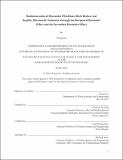| dc.contributor.advisor | Kathryn D. Held and Areg Danagoulian. | en_US |
| dc.contributor.author | Liu, Chang | en_US |
| dc.contributor.other | Massachusetts Institute of Technology. Department of Nuclear Science and Engineering. | en_US |
| dc.date.accessioned | 2017-01-30T18:51:00Z | |
| dc.date.available | 2017-01-30T18:51:00Z | |
| dc.date.copyright | 2016 | en_US |
| dc.date.issued | 2016 | en_US |
| dc.identifier.uri | http://hdl.handle.net/1721.1/106695 | |
| dc.description | Thesis: S.B., Massachusetts Institute of Technology, Department of Nuclear Science and Engineering, 2016. | en_US |
| dc.description | This electronic version was submitted by the student author. The certified thesis is available in the Institute Archives and Special Collections. | en_US |
| dc.description | Cataloged from student-submitted PDF version of thesis. | en_US |
| dc.description | Includes bibliographical references (pages 25-27). | en_US |
| dc.description.abstract | Aside from directly causing DNA damage, the traversal of radiation through cells also induces the bystander effect, which is the biological response of unirradiated cells that are neighboring or sharing medium with the irradiated cells. Although the mechanisms through which irradiated cells send signals to the bystander cells are not well understood, the bystander effect could potentially have clinical relevance or play a significant role in low dose radiation environments. The research in this thesis focuses on the ability of the bystander cells to influence the behavior of cells that share medium with them, which can be separated into three categories: unirradiated cells, irradiated cells, and the original irradiated cells that caused the bystander effect. These can be considered the "secondary bystanders." Human AG01522 fibroblasts were irradiated with 250 kVp X-rays and co-cultured with unirradiated fibroblasts to generate bystander cells, which were then cocultured with one of the three types of secondary bystander cells. The micronucleus assay was used to analyze the amount of chromosome aberrations present. In the unirradiated secondary bystander population, an increase in percentage of binucleated cells with micronuclei from the background level to approximately the level of the primary bystander cells was observed, indicating that bystander cells can send damaging signals. The data also showed that there was a lower frequency of micronuclei formation in the irradiated population with bystander inserts in comparison to irradiated populations without bystanders. However, there were no conclusive data on the effect of the bystander cells on other irradiated cells. Overall, the results suggest that bystander fibroblasts are capable of sending both detrimental and beneficial signals and can induce a range of behaviors in other cells. | en_US |
| dc.description.statementofresponsibility | by Chang Liu. | en_US |
| dc.format.extent | 28 pages | en_US |
| dc.language.iso | eng | en_US |
| dc.publisher | Massachusetts Institute of Technology | en_US |
| dc.rights | MIT theses are protected by copyright. They may be viewed, downloaded, or printed from this source but further reproduction or distribution in any format is prohibited without written permission. | en_US |
| dc.rights.uri | http://dspace.mit.edu/handle/1721.1/7582 | en_US |
| dc.subject | Nuclear Science and Engineering. | en_US |
| dc.title | Radiation-induced bystander fibroblasts both reduce and amplify micronuclei induction through the reciprocal bystander effect and the secondary bystander effect | en_US |
| dc.type | Thesis | en_US |
| dc.description.degree | S.B. | en_US |
| dc.contributor.department | Massachusetts Institute of Technology. Department of Nuclear Science and Engineering | |
| dc.identifier.oclc | 969781822 | en_US |
